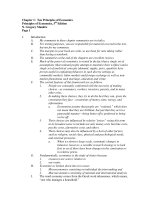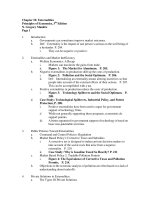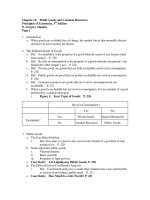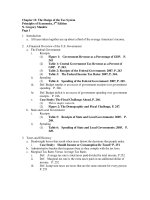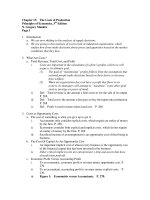Sách khuyến khích đọc - kinhtevimo M19
Bạn đang xem bản rút gọn của tài liệu. Xem và tải ngay bản đầy đủ của tài liệu tại đây (68.52 KB, 3 trang )
Chapter 19: Earnings and Discrimination
Principles of Economics, 5th Edition
N. Gregory Mankiw
Page 1
1.
This is an interesting chapter because it gives you a different perspective on a
controversial issue.
2.
Some Determinants of Equilibrium Wages
a.
Def: Compensating differentials are a difference in wages that arises to
offset the non-monetary characteristics of different jobs. P. 414.
b.
Def: Human capital is the accumulation of investments in people, such as
education and on the job training. P. 415.
c.
Case Study: The Increasing Value of Skills, P. 415.
i.
Alternative explanations:
(1)
international trade or
(2)
technological trade.
ii.
The ratio of college graduate earnings to high school graduate has
been increasing over the past decades.
(1)
This ratio understates the difference as better paid workers
usually have better fringe benefit packages.
iii.
Is this what you read in the newspapers--where bad news sells?
iv.
Table 1: Average Annual Earnings by Educational Attainment.
P. 416.
v.
Ability, effort, and change
(1)
Only half of wages is explained by observable variables.
(2)
In the News : The Loss of Manufacturing Jobs, P. 417.
d.
Case Study: The Benefits of Beauty, P. 418.
e.
An Alternative View Of Education: Signaling
i.
While signaling is important, it also introduces us to the idea that the
acquisition of information is a costly process, so rational people
pursue additional information only so long as they expect the
benefits to exceed the costs.
ii.
Everyone--including you--can spend a lot of time and money to
acquire information about a particular person, but you can
economize on the acquisition of information by relying on the
perceived mean values for a group: Harvard vs. Western New
Mexico, Men vs. Woman, Blacks vs. Asians, etc.
iii.
Why people have incentives to challenge erroneous stereotypes is
discussed below under discrimination by employers.
f.
The superstar phenomenon
i.
In the News: The Human Capital of Terrorists, P. 420
g.
Above-Equilibrium Wages: Minimum Wage Laws, Unions, and Efficient
Wages
3.
The Economics of Discrimination
a.
Def: Discrimination is the offering of different opportunities to similar
Chapter 19: Earnings and Discrimination
Principles of Economics, 5th Edition
N. Gregory Mankiw
Page 2
b.
c.
d.
individuals who differ only by race, ethnic group, sex, age, or other
personal characteristics. P. 422.
Measuring labor market discrimination
i.
While discrimination can affect wages, much of wages differentials
is based on differences in human capital and compensating wage
differentials.
ii.
Table 2: Median Annual Earnings by Race and Sex, P. 423.
iii.
Case Study: Is Emily more Employable than Lakisha?, P. 424.
Discrimination by employers
i.
If wages do not reflect productivity, employers have incentives to
compete for “underpaid” workers, reducing any effects of
discrimination.
(1)
However, there are profits to be made by challenging the
stereotypes, it they are wrong.
(2)
If the common perception is that female accountants are less
productive than males and, therefore, are paid less, then
employers who know that is not true have incentives to hire
female accountants--at lower wages--therefore, producing
higher profits for the company.
The higher profits will demonstrate the higher productivity
of female accountants, eventually increasing the
demand for them and, therefore, their earnings.
ii.
When there is no profit motive--government, for example--there is a
lower cost to exercising one’s preferences, so discrimination is less
costly and, therefore, more likely to occur.
iii.
Case Study: Segregated Streetcars and the Profit Motive, P.
425.
Discrimination can be caused by consumers’ preferences and government
action.
i.
If consumers prefer contact with certain types of workers, then that
will increase their demand and, potentially, their earnings.
(1)
Male accountants may earn more than female accountants if
customers of accounting firms prefer to deal with men.
ii.
Since the political process is based on majority rule--51 percent can
determine what everyone does, it does not permit the diversity that
would result in markets.
(1)
Prior to Brown vs. Board of Education, the south might have
had all black schools, all white schools and mixed schools
except for laws segregating blacks and whites.
iii.
Competitive markets contain a natural remedy for employer
discrimination.
iv.
In The News: Gender Differences, p. 426.
Chapter 19: Earnings and Discrimination
Principles of Economics, 5th Edition
N. Gregory Mankiw
Page 3
v.
vi.
vii.
Conclusion
Summary
The entry into the market of firms that care only about profit tends to
eliminate discriminatory wage differentials.
These wage differentials persist in competitive markets only when
customers are willing to pay to maintain the discriminatory practice
or when the government mandates it.
Case Study: Discrimination in Sports, P. 428





